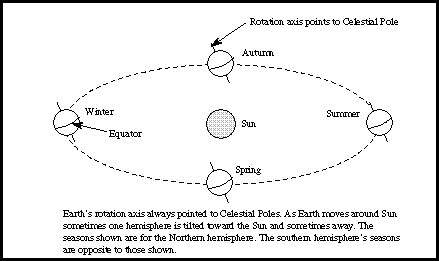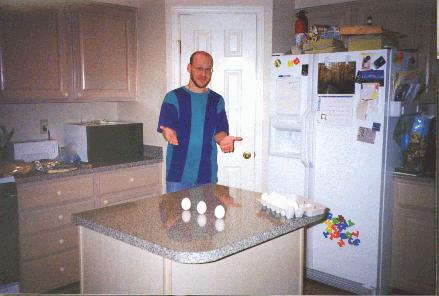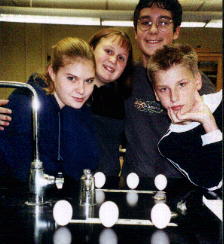
| Bad Astronomy |
|
|
|
BA Blog
|
|
Q & BA
|
|
Bulletin Board
|
| Media |
|
|
|
Bitesize Astronomy
|
|
Bad Astro Store
|
|
Mad Science
|
|
Fun Stuff
|
| Site Info |
|
|
|
Links
|
| RELATED SITES |
| - Universe Today |
| - APOD |
| - The Nine Planets |
| - Mystery Investigators |
| - Slacker Astronomy |
| - Skepticality |
Buy My Stuff

Keep Bad Astronomy close to your heart, and help make me
filthy rich. Hey, it's either this or one of those really
irritating PayPal donation buttons here.
Standing an egg on end on the Spring Equinox
SKIP DOWN TO THE EGG STANDING STUFF
NOTE ADDED March 20, 2011:
I have a fun video on how to stand an egg on end
on my blog at Discover Magazine.
Note added June 15, 2004: This page has been translated into Russian! My thanks to Sergei Zhukovich for doing this.
(September 23, 2003)
If you are coming from the Astronomy Picture of the Day, welcome!
If not, then
here's what I am talking about.
(April 23, 2003):
This is pretty cool: on this week's episode of "West Wing"
on NBC, a running theme throughout the show dealt with standing eggs
on end. At the end of the show, one of the characters looks up the
words "egg" and "equinox" on the web... and says it sent
him to "thingsthatarewrong.com". I happen to know better;
another character read off the screen, and it said "This has to be
one of the silliest misconceptions around, and it never seems to die."
That is a direct quote off this very egg standing page! So hey, if my
website is good enough for the staff of the fictitious White House,
it's good enough for anybody. Welcome.
 Note (March 20, 2002): My book, "Bad Astronomy",
has a longer description of the egg and the equinox
myth.
You can check it out here and order a copy if you'd like. You can
also read the first chapter, which is about egg standing!
Note (March 20, 2002): My book, "Bad Astronomy",
has a longer description of the egg and the equinox
myth.
You can check it out here and order a copy if you'd like. You can
also read the first chapter, which is about egg standing!
March 24, 2001:
Another equinox has come and gone, with more eggs and more email from
people either agreeing with me or arguing with me. I enjoy the email folks,
but please, stop sending me pictures! My buffer overfloweth! I
really appreciate the time and effort everyone has gone to, but
I now have dozens (cartons?) of digital pictures of eggs standing on end.
I'm not sure what to do with them all, and I hate to waste electrons. ;-)
So please, keep them in an album and show your kids. Or keep them in
albumen and eat them when you get the chance! ;-)
August 17, 2000:
I have a new page
discussing the history of this legend.
The story is actually pretty funny: this is all based on a cultural
mis-translation of dates!
Another page on this site tells the story of how I got some media interest for this page in the Spring of 1997. Check it out after you read this one!
Bad Astronomy: Only on the day of the Vernal (spring) Equinox,
can you stand a raw egg on its end.
Good astronomy: If you can stand a raw egg on end, it has
nothing to do with the Equinox.

How it works:
This has to be one of the silliest misconceptions around, and it
never seems to die. Every year, without fail, some TV station
broadcasts a news segment showing local
schoolchildren standing eggs on end on the
first day of spring. Usually, the newscaster will make some vague
mention about how this works, but
it is rarely specific, and never holds up to too much scrutiny.
We'll talk about one typical reason given in a moment, but first,
let's look at it from an astronomical angle:
what is special about the Spring (also called the Vernal) Equinox
that makes it different from any other time of the year?

The Earth's spin axis is tilted with respect to its orbital plane. This is what causes the seasons. When the Earth's axis points towards the Sun, it is summer for that hemisphere. When the Earth's axis points away, you get winter (from the diagram above you can see that the north end of the Earth's axis never points directly at the Sun, but on the summer solstice it points as close as it can, and on the winter solstice as far as it can. That diagram is taken from Nick Strobel's excellent Astronomy Notes website). Midway between these two times, in spring and autumn, the spin axis of the Earth points 90 degrees away from the Sun. Note that this happens twice a year, in spring and autumn. If you can stand an egg on its end on the Spring Equinox, surely you can on the Autumnal Equinox as well! Yet this always seems to get overlooked. That should be your first indication that something fishy is going on. Also note that the Vernal Equinox is actually heralding autumn in the southern hemisphere. Bad Reader Angela Alexander tells me that the egg myth is also around in Australia, although she admits she may have heard it on the web (which means it could have originated anywhere). Still, it's one more reason to doubt the "truth" behind the legend.
 So on the first day of spring, the Earth's axis happens to be
pointing perpendicularly to the direction of the Sun. Although it
might seem like a special event, all it really means is that
day and night have about the same length: 12 hours each, more or
less. Otherwise, it has no real manifestations
to us here on the surface; if you were locked in a windowless
box (hmmm, sounds like my old office) you would have no way of
knowing that it was the vernal equinox. As far as gravity goes,
there isn't anything special about this time.
So on the first day of spring, the Earth's axis happens to be
pointing perpendicularly to the direction of the Sun. Although it
might seem like a special event, all it really means is that
day and night have about the same length: 12 hours each, more or
less. Otherwise, it has no real manifestations
to us here on the surface; if you were locked in a windowless
box (hmmm, sounds like my old office) you would have no way of
knowing that it was the vernal equinox. As far as gravity goes,
there isn't anything special about this time.
I once heard a newscaster say that you can stand an egg on end during the Spring Equinox because the Sun's gravity "lines up with Earth's". This is just silly: draw a line between the center of the Earth and the Sun, and you'll see that at any time, someplace on the Earth is on that line! If there is any validity to this solar balance claim, then certainly it negates the Spring Equinox claim. I would hope our nation's television journalists would know better. I do a lot of hoping.
What I love about this example of Bad Astronomy is that you need not take my word on it. This is one you can prove for yourself!

At any day of the year, grab a carton of eggs and try to stand each one. Usually you cannot stand a raw egg because the inside of an egg is a very viscous (thick) liquid, and the yolk sits in this liquid. The yolk is usually a bit off-center and rides high in the egg, making it very difficult to balance. The egg falls over. However, with patience, you can usually make an egg stand up. It may take a lot of patience!

The pictures you see scattered around here were taken on October 25, 1998 (yes, that's me in that picture). Of course, I could be lying about the date, but again, you can prove this for yourself by trying to stand an egg on end on any random day. Go ahead and try it now! Whenever I buy eggs from the store I grab one or two from the carton and stand them up. It's fun. When the pictures here were taken in October of 1998, I was able to get three eggs standing pretty easily, then my wife helped me stand up five more!

So the question remains: why do eggs stand at all? I had a pretty good working theory about it. If you get an egg to stand up, leave it alone for a while to admire your hard won effort, then pick it up. Look at the bottom: there are tiny little bumps in the shell there, I'll wager. Those bumps are simply irregularities in the eggshell, and they act like little legs holding the egg up. That's what I figured makes the egg stand on end. It's not the vastness of space and the infinite grasp of gravity in balance; it's those stubby little bumps on the egg. I have found over and over again that smooth eggs are far more difficult to balance than rough ones.
I have also found that warm ones are easier to stand up as well, though I am not sure why. I originally thought that it might be because the liquid inside the egg thins out as it warms up, allowing the yolk can settle down farther. However, that turns out not to be the case. I chatted with Dr. David Swayne, who is a poultry veterinarian for the U.S. Department of Agriculture. He told me that the thickness of the albumen (the "white" part of the egg) does not depend on temperature. After all, the job of the albumen is to protect the yolk, and if it got thin when warm it wouldn't perform as well. So the mystery remains. I wonder: it takes time for an egg to warm up, and during that time I am trying to balance it. The more I try, the better I get! So I get better with time, and the egg warms with time. Maybe it's simply time that's important, and not temperature.
I mentioned above that I had a working theory about the bumps
on the bottom of the egg acting as stool legs. The past tense is important!
I recently received an email from Lisa Vincent, who teaches at the
Mancelona Middle School in Mancelona, Michigan. She and her class decided
to test the egg-myth for themselves, and had her students try it on
October 16, 1999 (coincidentally, almost exactly a year after the images
above were taken).
 Not only did they get eggs to balance, but they got them to
balance on their short ends! This is a feat I have never been
able to reproduce. For proof, they sent me images of their
eggs, which I present here. Note that the eggs are indeed standing
on their short ends. Incidentally, Ms. Vincent told me the eggs
remained standing for over a month. Usually a random vibration would knock
an egg over, but in the image it looks to me like they were standing on a
standard high school chemistry class work table and sink, which are
designed to be very sturdy. That was a good choice!
Not only did they get eggs to balance, but they got them to
balance on their short ends! This is a feat I have never been
able to reproduce. For proof, they sent me images of their
eggs, which I present here. Note that the eggs are indeed standing
on their short ends. Incidentally, Ms. Vincent told me the eggs
remained standing for over a month. Usually a random vibration would knock
an egg over, but in the image it looks to me like they were standing on a
standard high school chemistry class work table and sink, which are
designed to be very sturdy. That was a good choice!

The beauty of the Mancelona kids' work is that they showed me
what science means: sometimes you have to abandon a theory when a better
one comes along. I thought an egg could only balance on its fat end
(the narrow end usually is much smoother, making it harder to balance),
but they proved me wrong. Since I knew it could be done, I kept
at it, and now I am happy (and oddly proud) to say that I have indeed
managed to get an egg to stand on its narrow end.
Bottom line: if an egg stands on end, it would do it at any time, and not just at the equinox. The equinox has nothing to do with it. And here's a good rule: if you see it on your local news, ask yourself, did that make sense? Is there any way I can prove or disprove that myself? Sometimes it pays to question the national news as well.
Congratulations! Once you do this, you will be on the road to rational thinking. As Richard Feynman said, "Science is a way for us to not fool ourselves."
Thanks to Bad reader Lukasz Salwinski for pointing out that the yolk of a raw egg is what makes it hard to balance it.
There are more pages out there with Egg and the Equinox links:
- I thought I was pretty good at standing eggs, until I got an email
from a guy who balanced 1290 with a group of friends!
That was enough for a world record:
read all about (and look at some pretty amazing pictures, too).
- Read my own page about when a local
weatherman (on my suggestion) took this myth to task.
-
The Straight Dope has a pretty humorous look at the silly legend.
-
NCAE Online
has links to many other great Equinox resources.
-
The Science Alliance
has a page about eggs and the VE,
where they describe how they
trick teachers into standing eggs on the Summer Solstice.
Heehee!
-
Another good page can be found at
the currentsky.com website.
- Egg facts, care of the American Egg Board.
- A page with much the same content as this one but with more history of the legend can be found at the Clark Foundation website.
|
|
|
|